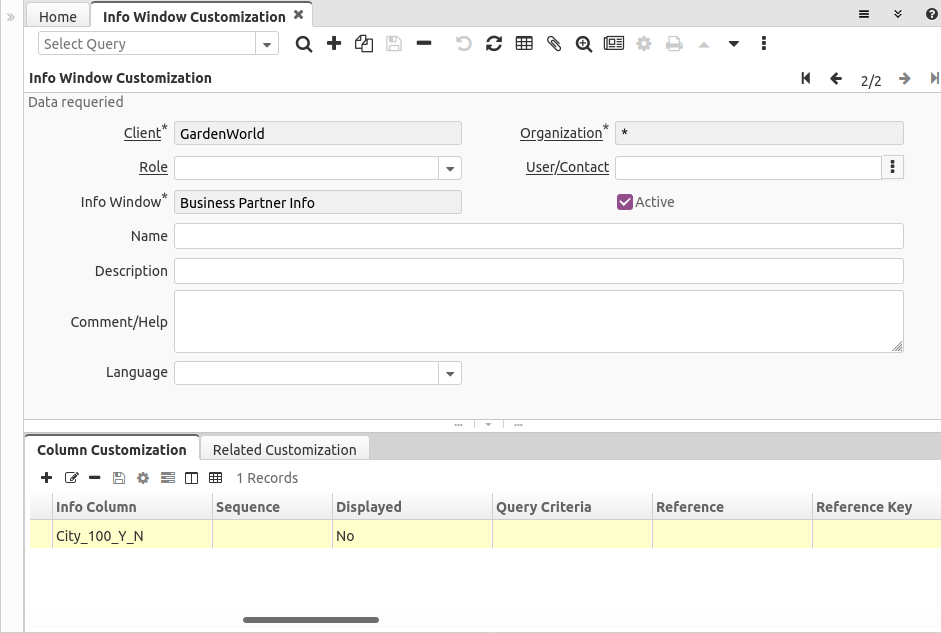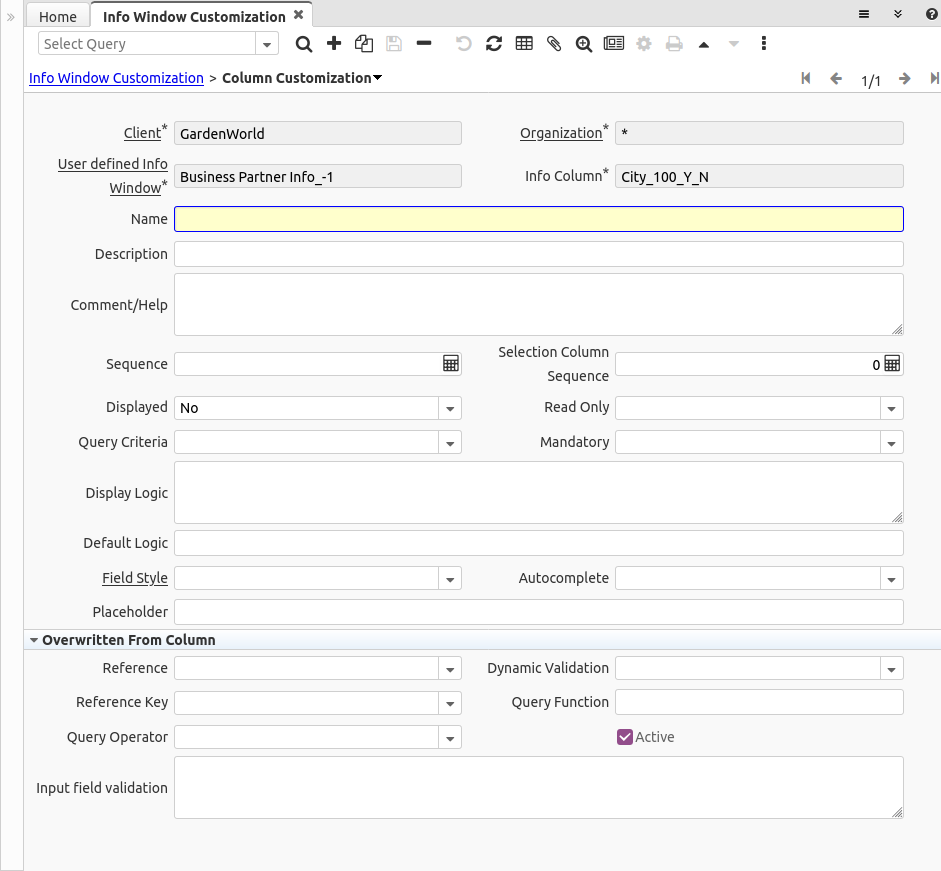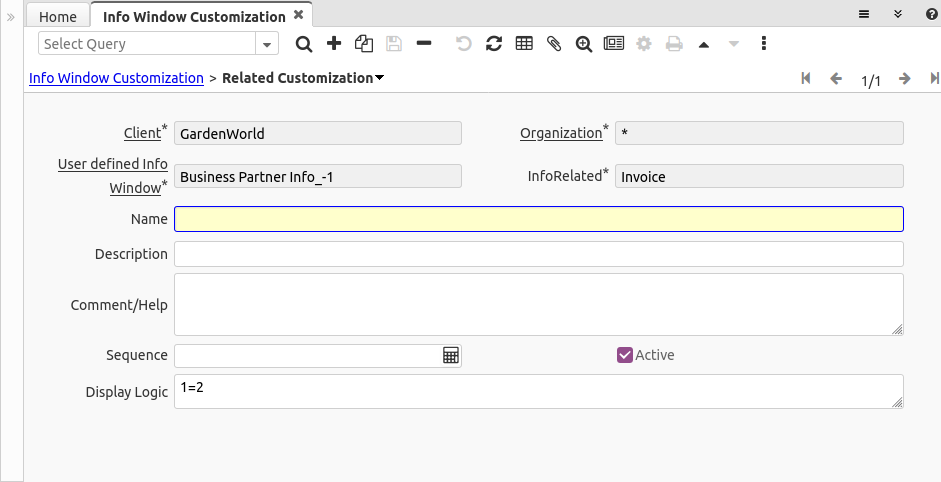Info Window Customization (Window ID-200110)
Window: Info Window Customization
Description: Define Info Window Customization for Role/User
Help: The customization values defined here overwrite/replace the default system definition if defined.
Tab: Info Window Customization
Description:
Help:
| Name | Description | Help | Technical Data |
|---|---|---|---|
| Tenant | Tenant for this installation. | A Tenant is a company or a legal entity. You cannot share data between Tenants. | AD_UserDef_Info.AD_Client_ID numeric(10) Table Direct |
| Organization | Organizational entity within tenant | An organization is a unit of your tenant or legal entity - examples are store, department. You can share data between organizations. | AD_UserDef_Info.AD_Org_ID numeric(10) Table Direct |
| Role | Responsibility Role | The Role determines security and access a user who has this Role will have in the System. | AD_UserDef_Info.AD_Role_ID numeric(10) Table Direct |
| User/Contact | User within the system - Internal or Business Partner Contact | The User identifies a unique user in the system. This could be an internal user or a business partner contact | AD_UserDef_Info.AD_User_ID numeric(10) Search |
| Info Window | Info and search/select Window | The Info window is used to search and select records as well as display information relevant to the selection. | AD_UserDef_Info.AD_InfoWindow_ID numeric(10) Table Direct |
| Active | The record is active in the system | There are two methods of making records unavailable in the system: One is to delete the record, the other is to de-activate the record. A de-activated record is not available for selection, but available for reports.
There are two reasons for de-activating and not deleting records: (1) The system requires the record for audit purposes. (2) The record is referenced by other records. E.g., you cannot delete a Business Partner, if there are invoices for this partner record existing. You de-activate the Business Partner and prevent that this record is used for future entries. |
AD_UserDef_Info.IsActive character(1) Yes-No |
| Name | Alphanumeric identifier of the entity | The name of an entity (record) is used as an default search option in addition to the search key. The name is up to 60 characters in length. | AD_UserDef_Info.Name character varying(60) String |
| Description | Optional short description of the record | A description is limited to 255 characters. | AD_UserDef_Info.Description character varying(255) String |
| Comment/Help | Comment or Hint | The Help field contains a hint, comment or help about the use of this item. | AD_UserDef_Info.Help character varying(2000) Text |
| Language | Language for this entity | The Language identifies the language to use for display and formatting | AD_UserDef_Info.AD_Language character varying(6) Table |
| Show in Dashboard | Show the dashlet in the dashboard | AD_UserDef_Info.IsShowInDashboard character(1) List | |
| Sequence | Method of ordering records; lowest number comes first | The Sequence indicates the order of records | AD_UserDef_Info.SeqNo numeric(10) Integer |
| Image URL | URL of image | URL of image; The image is not stored in the database, but retrieved at runtime. The image can be a gif, jpeg or png. | AD_UserDef_Info.ImageURL character varying(120) String |
| Window | Data entry or display window | The Window field identifies a unique Window in the system. | AD_UserDef_Info.AD_Window_ID numeric(10) Table Direct |
| PO Window | Purchase Order Window | Window for Purchase Order (AP) Zooms | AD_UserDef_Info.PO_Window_ID numeric(10) Table |
Tab: Column Customization
Description:
Help:
| Name | Description | Help | Technical Data |
|---|---|---|---|
| Tenant | Tenant for this installation. | A Tenant is a company or a legal entity. You cannot share data between Tenants. | AD_UserDef_Info_Column.AD_Client_ID numeric(10) Table Direct |
| Organization | Organizational entity within tenant | An organization is a unit of your tenant or legal entity - examples are store, department. You can share data between organizations. | AD_UserDef_Info_Column.AD_Org_ID numeric(10) Table Direct |
| User defined Info Window | AD_UserDef_Info_Column.AD_UserDef_Info_ID numeric(10) Table Direct | ||
| Info Column | Info Window Column | Column in the Info Window for display and/or selection. If used for selection, the column cannot be a SQL expression. The SQL clause must be fully qualified based on the FROM clause in the Info Window definition | AD_UserDef_Info_Column.AD_InfoColumn_ID numeric(10) Table Direct |
| Name | Alphanumeric identifier of the entity | The name of an entity (record) is used as an default search option in addition to the search key. The name is up to 60 characters in length. | AD_UserDef_Info_Column.Name character varying(60) String |
| Description | Optional short description of the record | A description is limited to 255 characters. | AD_UserDef_Info_Column.Description character varying(255) String |
| Comment/Help | Comment or Hint | The Help field contains a hint, comment or help about the use of this item. | AD_UserDef_Info_Column.Help character varying(2000) Text |
| Sequence | Method of ordering records; lowest number comes first | The Sequence indicates the order of records | AD_UserDef_Info_Column.SeqNo numeric(10) Integer |
| Selection Column Sequence | Selection Column Sequence | For ordering sequence of selection column | AD_UserDef_Info_Column.SeqNoSelection numeric(10) Integer |
| Displayed | Determines, if this field is displayed | If the field is displayed, the field Display Logic will determine at runtime, if it is actually displayed | AD_UserDef_Info_Column.IsDisplayed character(1) List |
| Read Only | Field is read only | The Read Only indicates that this field may only be Read. It may not be updated. | AD_UserDef_Info_Column.IsReadOnly character(1) List |
| Query Criteria | The column is also used as a query criteria | The column is used to enter queries - the SQL cannot be an expression | AD_UserDef_Info_Column.IsQueryCriteria character(1) List |
| Mandatory | Data entry is required in this column | The field must have a value for the record to be saved to the database. | AD_UserDef_Info_Column.IsMandatory character(1) List |
| Query After Change | Issues a query request after the user has made changes to the field | AD_UserDef_Info_Column.IsQueryAfterChange character(1) List | |
| Display Logic | If the Field is displayed, the result determines if the field is actually displayed | format := {expression} [{logic} {expression}] expression := @{context}@{operand}{value} or @{context}@{operand}{value}
Strings may be in single quotes (optional) |
AD_UserDef_Info_Column.DisplayLogic character varying(2000) Text |
| Default Logic | Default value hierarchy, separated by ; | The defaults are evaluated in the order of definition, the first not null value becomes the default value of the column. The values are separated by comma or semicolon. a) Literals:. 'Text' or 123 b) Variables - in format @Variable@ - Login e.g. #Date, #AD_Org_ID, #AD_Tenant_ID - Accounting Schema: e.g. , - Global defaults: e.g. DateFormat - Window values (all Picks, CheckBoxes, RadioButtons, and DateDoc/DateAcct) c) SQL code with the tag: @SQL=SELECT something AS DefaultValue FROM ... The SQL statement can contain variables. There can be no other value other than the SQL statement. The default is only evaluated, if no user preference is defined. Default definitions are ignored for record columns as Key, Parent, Tenant as well as Buttons. | AD_UserDef_Info_Column.DefaultValue character varying(2000) String |
| Field Style | Field CSS Style | AD_UserDef_Info_Column.AD_FieldStyle_ID numeric(10) Table | |
| Auto complete | Automatic completion for text fields | The autocompletion uses all existing values (from the same tenant and organization) of the field. | AD_UserDef_Info_Column.IsAutocomplete character(1) List |
| Placeholder | AD_UserDef_Info_Column.Placeholder character varying(255) String | ||
| Reference | System Reference and Validation | The Reference could be a display type, list or table validation. | AD_UserDef_Info_Column.AD_Reference_ID numeric(10) Table |
| Dynamic Validation | Dynamic Validation Rule | These rules define how an entry is determined to valid. You can use variables for dynamic (context sensitive) validation. | AD_UserDef_Info_Column.AD_Val_Rule_ID numeric(10) Table Direct |
| Reference Key | Required to specify, if data type is Table or List | The Reference Value indicates where the reference values are stored. It must be specified if the data type is Table or List. | AD_UserDef_Info_Column.AD_Reference_Value_ID numeric(10) Table |
| Query Function | Database function for query | Database function for user query. If the database function takes more than just the column name parameter, use ? to indicate where the column name should goes to. E.g: Upper, Trunc and To_Char(?,'MM') | AD_UserDef_Info_Column.QueryFunction character varying(2000) String |
| Query Operator | Operator for database query | AD_UserDef_Info_Column.QueryOperator character varying(10) List | |
| Active | The record is active in the system | There are two methods of making records unavailable in the system: One is to delete the record, the other is to de-activate the record. A de-activated record is not available for selection, but available for reports.
There are two reasons for de-activating and not deleting records: (1) The system requires the record for audit purposes. (2) The record is referenced by other records. E.g., you cannot delete a Business Partner, if there are invoices for this partner record existing. You de-activate the Business Partner and prevent that this record is used for future entries. |
AD_UserDef_Info_Column.IsActive character(1) Yes-No |
| Input field validation | Input field validation query | Input field validation query | AD_UserDef_Info_Column.InputFieldValidation character varying(2000) Text |
Tab: Related Customization
Description:
Help:
| Name | Description | Help | Technical Data |
|---|---|---|---|
| Tenant | Tenant for this installation. | A Tenant is a company or a legal entity. You cannot share data between Tenants. | AD_UserDef_Info_Related.AD_Client_ID numeric(10) Table Direct |
| Organization | Organizational entity within tenant | An organization is a unit of your tenant or legal entity - examples are store, department. You can share data between organizations. | AD_UserDef_Info_Related.AD_Org_ID numeric(10) Table Direct |
| User defined Info Window | AD_UserDef_Info_Related.AD_UserDef_Info_ID numeric(10) Table Direct | ||
| Info Related | AD_UserDef_Info_Related.AD_InfoRelated_ID numeric(10) Table Direct | ||
| Name | Alphanumeric identifier of the entity | The name of an entity (record) is used as an default search option in addition to the search key. The name is up to 60 characters in length. | AD_UserDef_Info_Related.Name character varying(60) String |
| Description | Optional short description of the record | A description is limited to 255 characters. | AD_UserDef_Info_Related.Description character varying(255) String |
| Comment/Help | Comment or Hint | The Help field contains a hint, comment or help about the use of this item. | AD_UserDef_Info_Related.Help character varying(2000) Text |
| Sequence | Method of ordering records; lowest number comes first | The Sequence indicates the order of records | AD_UserDef_Info_Related.SeqNo numeric(10) Integer |
| Active | The record is active in the system | There are two methods of making records unavailable in the system: One is to delete the record, the other is to de-activate the record. A de-activated record is not available for selection, but available for reports.
There are two reasons for de-activating and not deleting records: (1) The system requires the record for audit purposes. (2) The record is referenced by other records. E.g., you cannot delete a Business Partner, if there are invoices for this partner record existing. You de-activate the Business Partner and prevent that this record is used for future entries. |
AD_UserDef_Info_Related.IsActive character(1) Yes-No |
| Display Logic | If the Field is displayed, the result determines if the field is actually displayed | format := {expression} [{logic} {expression}] expression := @{context}@{operand}{value} or @{context}@{operand}{value}
Strings may be in single quotes (optional) |
AD_UserDef_Info_Related.DisplayLogic character varying(2000) Text |
Contributions / Posts
- See also NF8.2 Info Window Customisation



